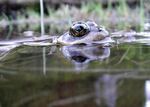The Northwest is looking at another dry, low snowpack year. That’s bad news for the frogs, salamanders and newts that live at high elevation in Oregon and Washington.
A new study, published in the journal Ecological Society of America, finds that increasing temperatures and decreasing snowpack could put populations of the Cascades frog, Rana cascadae, at risk of extinction by 2080.
The results were something of a surprise to the researchers, who thought that warmer, longer summers might actually help the high-elevation frogs. A longer summer would mean a longer growing season and more time for the frogs to load up on insects and get ready for hibernation.

Cascades frogs like this one face multiple threats: they're eaten by non-native trout, and now, increasingly, they're losing habitat to climate change.
M. Ryan/University of Washington
“It started out as a potential good-news climate story,” says ecologist Amanda Kissel, who was at Simon Fraser University in British Columbia at the time, and is now with Conservation Science Partners in Colorado.
But that good news wasn’t reflected in the data. Instead, they found that snow-light winters and long summers meant drier ponds. And that meant less availability of crucial habitat for the frogs, which are listed as “near-threatened” by the International Union for Conservation of Nature.
For 15 years, researchers have trekked miles through the early-summer Olympics snow to their study sites, where they tagged adult frogs and tracked their abundance. Kissel says Olympic National Park is a perfect place to study the effects of climate change on frogs because it’s protected from the sorts of land-use changes, like logging, that hurt or help native animals. It’s also isolated, and amphibian-killing diseases such as chytrid fungus are rare there. The results were clear: warm, dry winters meant less frogs.
Then, they combined that data with models of how specific watersheds and ponds were expected to change because of global warming.
Related: Snowpack In The West Has Resisted Climate Change But That Won't Last Forever
That data showed that warmer summers had the biggest impact on tadpoles. Unlike adult frogs, tadpoles are fully aquatic. They have gills and lack lungs, and they can’t breathe outside of water. Most of the ponds tadpoles hatch in are seasonal and fed by snowmelt, so some disappear by the end of the summer. If they dry up too soon, so do the tadpoles. Their model showed that 17 percent more tadpoles would die due to pond drying by 2080.
Adult frogs won’t escape, either. Adult survival is expected to decrease by 7 percent by 2080 — and since the adults lay the eggs, that has a big impact on the total population numbers. It’s possible that warmer winters could harm the frogs, too, and not just summers. Normally, they hibernate all winter and save energy. But the warmth could temporarily wake them up, causing them to burn calories that they can’t replace until snowmelt.
Seventeen and 7 percent may not seem like a lot, but they add up. By 2080, populations of frogs would be going extinct in 62 percent of the scenarios they ran. And this was under a middle-of-the-road climate scenario, one where some progress is made on curbing emissions. It could look a lot worse.
Although this study only looked at one species of frog in one location, Kissel says the research applies to amphibians throughout the Northwest. Salamanders and newts also rely on these seasonal ponds to reproduce and face the same challenges.
There might be a way to save the frogs and other native amphibians from extinction: Not all of the ponds in the Cascades evaporate by the end of summer. The larger lakes could serve as “climate change refuges” for the frogs, Kissel says. But many of the lakes are also stocked with non-native fish for anglers, and those fish eat amphibians. University scientists have been collaborating with national park officials to figure out which lakes are best-suited to frogs, and which lakes would be the easiest to remove trout from.